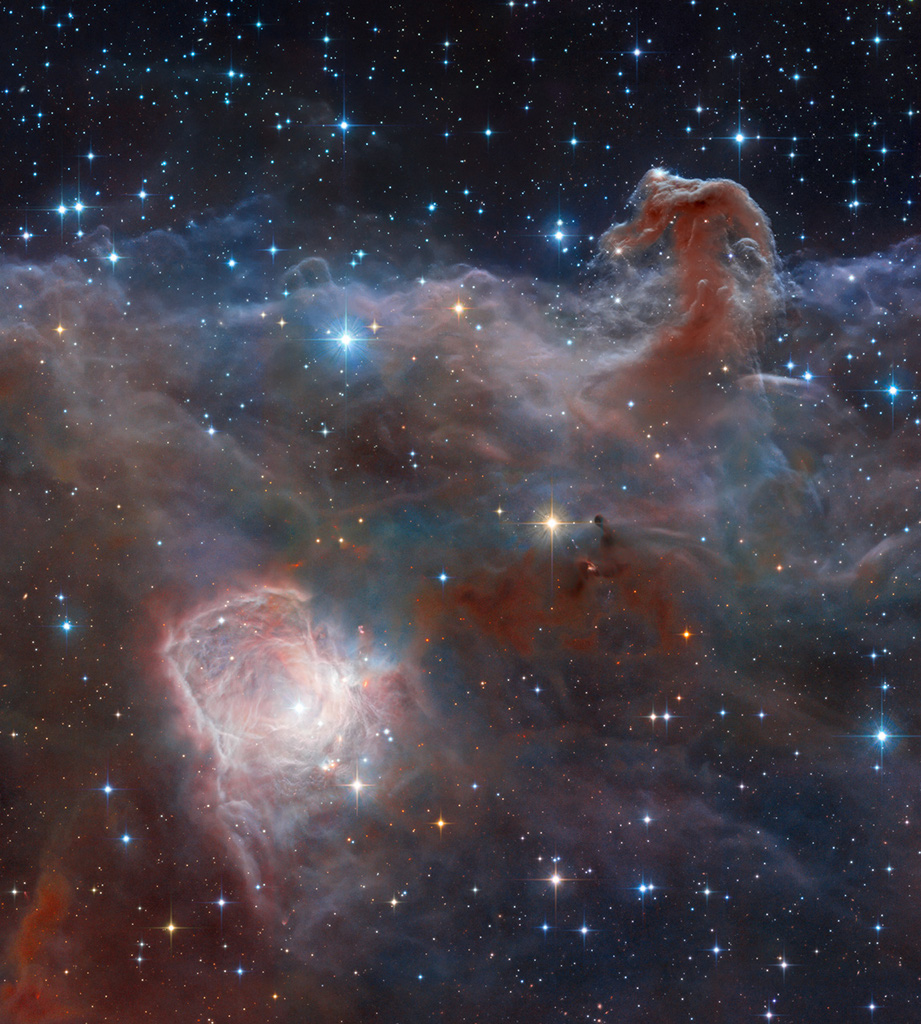
|
| Title: NASA pics | |
| Grapevine50sRoost > ~GENERAL~ > GENERAL DISCUSSION | Go to subcategory: |
| Author | Content |
|
zxxlyzq
|
|
|
Date Posted:09/03/2018 12:10 PMCopy HTML Composition and Processing: Robert Gendler Image Data: ESO, VISTA, HLA, Hubble Heritage Team (STScI/AURA) Explanation: Combined image data from the massive, ground-based VISTA telescope and the Hubble Space Telescope was used to create this wide perspective of the interstellar landscape surrounding the famous Horsehead Nebula. Captured at near-infrared wavelengths, the region's dusty molecular cloud sprawls across the scene that covers an angle about two-thirds the size of the Full Moon on the sky. Left to right the frame spans just over 10 light-years at the Horsehead's estimated distance of 1,600 light-years. Also known as Barnard 33, the still recognizable Horsehead Nebula stands at the upper right, the near-infrared glow of a dusty pillar topped with newborn stars. Below and left, the bright reflection nebula NGC 2023 is itself the illuminated environs of a hot young star. Obscuring clouds below the base of the Horsehead and on the outskirts of NGC 2023 show the tell-tale far red emission of energetic jets, known as Herbig-Haro objects, also associated with newborn stars. |
|
|
Megan57
|
Share to:





 #181
#181
|
|
Re:NASA pics Date Posted:26/06/2025 6:04 AMCopy HTML
|
|
|
Rockymz
|
Share to:





 #182
#182
|
|
Re:NASA pics Date Posted:25/06/2025 8:48 AMCopy HTML
Image Credit & License: NSF–DOE Vera C. Rubin Observatory Explanation: This interstellar skyscape spans over 4 degrees across crowded starfields toward the constellation Sagittarius and the central Milky Way. A First Look image captured at the new NSF–DOE Vera C. Rubin Observatory, the bright nebulae and star clusters featured include famous stops on telescopic tours of the cosmos: Messier 8 and Messier 20. An expansive star-forming region over a hundred light-years across, Messier 8 is also known as the Lagoon Nebula. About 4,000 light-years away the Lagoon Nebula harbors a remarkable cluster of young, massive stars. Their intense radiation and stellar winds energize and agitate this cosmic lagoon's turbulent depths. Messier 20's popular moniker is the Trifid. Divided into three parts by dark interstellar dust lanes, the Trifid Nebula's glowing hydrogen gas creates its dominant red color. But contrasting blue hues in the colorful Trifid are due to dust reflected starlight. The Rubin Observatory visited the Trifid-Lagoon field to acquire all the image data during parts of four nights (May 1-4). At full resolution, Rubin's magnificent Sagittarius skyscape is 84,000 pixels wide and 51,500 pixels tall. |
|
|
Megan57
|
Share to:





 #183
#183
|
|
Re:NASA pics Date Posted:25/06/2025 5:55 AMCopy HTML
|
|
|
Rockymz
|
Share to:





 #184
#184
|
|
Re:NASA pics Date Posted:24/06/2025 7:50 AMCopy HTML Image Credit: NASA, ESA, Hubble, ESO; Processing & Copyright: Robert Gendler Explanation: Is there a spiral galaxy in the center of this spiral galaxy? Sort of. Image data from the Hubble Space Telescope, the European Southern Observatory, and smaller telescopes on planet Earth are combined in this detailed portrait of face-on spiral galaxy Messier 61 (M61) and its bright center. A mere 55 million light-years away in the Virgo Cluster of Galaxies, M61 is also known as NGC 4303. It's considered to be an example of a barred spiral galaxy similar to our own Milky Way. Like other spiral galaxies, M61 also features sweeping spiral arms, cosmic dust lanes, pinkish star forming regions, and young blue star clusters. Its core houses an active supermassive black hole surrounded by a bright nuclear spiral -- infalling star-forming gas that itself looks like a separate spiral galaxy. |
|
|
Megan57
|
Share to:





 #185
#185
|
|
Re:NASA pics Date Posted:23/06/2025 7:30 AMCopy HTML
|
|
|
Rockymz
|
Share to:





 #186
#186
|
|
Re:NASA pics Date Posted:23/06/2025 7:11 AMCopy HTML Image Credit: NASA, WISE, IRSA; Processing & Copyright : Francesco Antonucci Explanation: How do stars form? Images of the star forming region W5 like those in the infrared by NASA's Wide Field Infrared Survey Explorer (WISE, later NEOWISE) satellite provide clear clues with indications that massive stars near the center of empty cavities are older than stars near the edges. A likely reason for this is that the older stars in the center are actually triggering the formation of the younger edge stars. The triggered star formation occurs when hot outflowing gas compresses cooler gas into knots dense enough to gravitationally contract into stars. In the featured scientifically colored infrared image, spectacular pillars left slowly evaporating from the hot outflowing gas provide further visual clues. W5 is also known as Westerhout 5 (W5) and IC 1848. Together with IC 1805, the nebulas form a complex region of star formation popularly dubbed the Heart and Soul Nebulas. The featured image highlights a part of W5 spanning about 2,000 light years that is rich in star forming pillars. W5 lies about 6,500 light years away toward the constellation of Cassiopeia. |
|
|
Rockymz
|
Share to:





 #187
#187
|
|
Re:NASA pics Date Posted:22/06/2025 6:43 AMCopy HTML Image Credit: NASA, JPL, Curiosity Rover Explanation: How were these unusual Martian spherules created? Thousands of unusual gray spherules made of iron and rock and dubbed blueberries were found embedded in and surrounding rocks near the landing site of the robot Opportunity rover on Mars in 2004. To help investigate their origin, Opportunity found a surface dubbed the Berry Bowl with an indentation that was rich in the Martian orbs. The Berry Bowl is pictured here, imaged during rover's 48th Martian day. The average size of a Martian blueberry rock is only about 4 millimeters across. By analyzing a circular patch in the rock surface to the left of the densest patch of spherules, Opportunity obtained data showing that the underlying rock has a much different composition than the hematite rich blueberries. This information contributes to the growing consensus that these small, strange, gray orbs were slowly deposited from a bath of dirty water. |
|
|
Megan57
|
Share to:





 #188
#188
|
|
Re:NASA pics Date Posted:22/06/2025 5:45 AMCopy HTML Amazing Rocky thank you x |
|
|
Rockymz
|
Share to:





 #189
#189
|
|
Re:NASA pics Date Posted:21/06/2025 8:55 AMCopy HTML Image Credit: (left) Copyright: Tunc Tezel (TWAN) - (right): NASA/JPL/Cornell/ASU/TAMU Explanation: Sure, that figure-8 shaped curve you get when you mark the position of the Sun in Earth's sky at the same time each day over one year is called an analemma. On the left, Earth's figure-8 analemma was traced by combining wide-angle digital images recorded during the year from December 2011 through December 2012. But the shape of an analemma depends on the eccentricity of a planet's orbit and the tilt of its axis of rotation, so analemma curves can look different for different worlds. Take Mars for example. The Red Planet's axial tilt is similar to Earth's, but its orbit around the same sun is more eccentric (less circular) than Earth's orbit. As seen from the Martian surface, the analemma traced in the right hand panel is shaped more like a tear drop. The Mars rover Opportunity captured the images used over the Martian year corresponding to Earth dates July 2006 to June 2008. Of course, each world's solstice dates still lie at the top and bottom of their different analemma curves. The last Mars northern summer solstice was May 29, 2025. Our fair planet's 2025 northern summer solstice is at June 21, 2:42 UTC. |
|
|
Megan57
|
Share to:





 #190
#190
|
|
Re:NASA pics Date Posted:21/06/2025 6:58 AMCopy HTML
|
|
|
Rockymz
|
Share to:





 #191
#191
|
|
Re:NASA pics Date Posted:20/06/2025 8:00 AMCopy HTML Image Credit & Copyright: Luca Vanzella, Alister Ling Explanation: Edmonton, Alberta, Canada, planet Earth lies on the horizon. in this stack of panoramic composite images. In a monthly time series arranged vertically top to bottom the ambitious photographic project follows the annual north-south swing of sunrise points, from June solstice to December solstice and back again. It also follows the corresponding, but definitely harder to track, Full Moon rise. Of course, the north-south swing of moonrise runs opposite sunrise along the horizon. But these rising Full Moons also span a wider range on the horizon than the sunrises. That's because the well-planned project (as shown in this video) covers the period June 2024 to June 2025, centered on a major lunar standstill. Major lunar standstills represent extremes in the north-south range of moonrise driven by the 18.6 year precession period of the lunar orbit. |
|
|
Megan57
|
Share to:





 #192
#192
|
|
Re:NASA pics Date Posted:19/06/2025 10:32 AMCopy HTML
|
|
|
Rockymz
|
Share to:





 #193
#193
|
|
Re:NASA pics Date Posted:19/06/2025 8:22 AMCopy HTML Image Credit & Copyright: Vikas Chander Explanation: Gorgeous spiral galaxy NGC 3521 is a mere 35 million light-years away, toward the northern springtime constellation Leo. Relatively bright in planet Earth's sky, NGC 3521 is easily visible in small telescopes but often overlooked by amateur imagers in favor of other Leo spiral galaxies, like M66 and M65. It's hard to overlook in this colorful cosmic portrait though. Spanning some 50,000 light-years the galaxy sports characteristic patchy, irregular spiral arms laced with dust, pink star forming regions, and clusters of young, blue stars. The deep image also finds NGC 3521 embedded in fainter, gigantic, bubble-like shells. The shells are likely tidal debris, streams of stars torn from satellite galaxies that have undergone mergers with NGC 3521 in the distant past. |
|
|
Rockymz
|
Share to:





 #194
#194
|
|
Re:NASA pics Date Posted:18/06/2025 7:08 AMCopy HTML Image Credit & Copyright: Eric Holland Explanation: What's that unusual spot on the Moon? It's the International Space Station. Using precise timing, the Earth-orbiting space platform was photographed in front of a partially lit gibbous Moon in 2019. The featured image was taken from Palo Alto, California, USA with an exposure time of only 1/667 of a second. In contrast, the duration of the transit of the ISS across the entire Moon was about half a second. A close inspection of this unusually crisp ISS silhouette will reveal the outlines of numerous solar panels and trusses. The bright crater Tycho is visible on the lower left, as well as comparatively rough, light colored terrain known as highlands and relatively smooth, dark colored areas known as maria. Downloadable apps can tell you when the International Space Station will be visible from your area. |
|
|
Megan57
|
Share to:





 #195
#195
|
|
Re:NASA pics Date Posted:18/06/2025 6:33 AMCopy HTML
|
|
|
Rockymz
|
Share to:





 #196
#196
|
|
Re:NASA pics Date Posted:17/06/2025 7:45 AMCopy HTML Image Credit: Toni Fabiani Méndez Explanation: Can you find the Rosette Nebula? The red flowery-looking nebula just above the image center may seem a good choice, but that's not it. The famous Rosette Nebula is really located on the lower right, here colored blue and white, and connected to the other nebulas by gold-colored filaments. Because the featured image of Rosette's field is so wide, and because of its deep red exposure, it seems to contain other flowers. Designated NGC 2237, the center of the Rosette Nebula is populated by the bright blue stars of open cluster NGC 2244, whose winds and energetic light are evacuating the nebula's center. The Rosette Nebula is about 5,000 light years distant and, just by itself, spans about three times the diameter of a full moon. This flowery field can be found toward the constellation of the Unicorn (Monoceros). |
|
|
Megan57
|
Share to:





 #197
#197
|
|
Re:NASA pics Date Posted:17/06/2025 6:03 AMCopy HTML Happy 30th APOD thanks Rocky x |
|
|
Rockymz
|
Share to:





 #198
#198
|
|
Re:NASA pics Date Posted:16/06/2025 8:56 AMCopy HTML Image Credit: Pixelization of Van Gogh's The Starry Night by Dario Giannobile Explanation: APOD is 30 years old today. In celebration, today's picture uses past APODs as tiles arranged to create a single pixelated image that might remind you of one of the most well-known and evocative depictions of planet Earth's night sky. In fact, this Starry Night consists of 1,836 individual images contributed to APOD over the last 5 years in a mosaic of 32,232 tiles. Today, APOD would like to offer a sincere thank you to our contributors, volunteers, and readers. Over the last 30 years your continuing efforts have allowed us to enjoy, inspire, and share a discovery of the cosmos. |
|
|
Megan57
|
Share to:





 #199
#199
|
|
Re:NASA pics Date Posted:16/06/2025 7:06 AMCopy HTML
|
|
|
Rockymz
|
Share to:





 #200
#200
|
|
Re:NASA pics Date Posted:15/06/2025 7:32 AMCopy HTML Left Image Credit & Copyright: Damia Bouic; Right Image Credit: NASA, JPL-Caltech, MSSS; Digital processing: Damia Bouic Explanation: How different does sunset appear from Mars than from Earth? For comparison, two images of our common star were taken at sunset, one from Earth and one from Mars. These images were scaled to have the same angular width and are featured here side-by-side. A quick inspection will reveal that the Sun appears slightly smaller from Mars than from Earth. This makes sense since Mars is 50% further from the Sun than Earth. More striking, perhaps, is that the Martian sunset is noticeably bluer near the Sun than the typically orange colors near the setting Sun from Earth. The reason for the blue hues from Mars is not fully understood, but thought to be related to forward scattering properties of Martian dust. The terrestrial sunset was taken in 2012 March from Marseille, France, while the Martian sunset was captured in 2015 by NASA's robotic Curiosity rover from Gale crater on Mars. |
|
|
Rockymz
|
Share to:





 #201
#201
|
|
Re:NASA pics Date Posted:15/06/2025 7:32 AMCopy HTML Left Image Credit & Copyright: Damia Bouic; Right Image Credit: NASA, JPL-Caltech, MSSS; Digital processing: Damia Bouic Explanation: How different does sunset appear from Mars than from Earth? For comparison, two images of our common star were taken at sunset, one from Earth and one from Mars. These images were scaled to have the same angular width and are featured here side-by-side. A quick inspection will reveal that the Sun appears slightly smaller from Mars than from Earth. This makes sense since Mars is 50% further from the Sun than Earth. More striking, perhaps, is that the Martian sunset is noticeably bluer near the Sun than the typically orange colors near the setting Sun from Earth. The reason for the blue hues from Mars is not fully understood, but thought to be related to forward scattering properties of Martian dust. The terrestrial sunset was taken in 2012 March from Marseille, France, while the Martian sunset was captured in 2015 by NASA's robotic Curiosity rover from Gale crater on Mars. |
|
|
Megan57
|
Share to:





 #202
#202
|
|
Re:NASA pics Date Posted:14/06/2025 8:34 AMCopy HTML Fascinating Rocky thank you x |
|
|
Rockymz
|
Share to:





 #203
#203
|
|
Re:NASA pics Date Posted:14/06/2025 8:31 AMCopy HTML
Image Credit & Copyright: Martín Moliné Explanation: What are all those streaks in the sky? A galaxy, many satellite trails, and a few meteors. First, far in the distance, the majestic band of our Milky Way Galaxy runs down the left. Mirroring it on the right are several parallel trails of Earth-orbiting Starlink satellites. Many fainter satellite trails also crisscross the image. The two short and bright streaks are meteors — likely members of the annual Eta Aquariids meteor shower. The planet Venus shines on the lower right. Venus and the satellites shine by reflected sunlight. The featured picture is a composite of exposures all taken in a few hours on May 4 over the Limay River in Argentina. |
|
|
Rockymz
|
Share to:





 #204
#204
|
|
Re:NASA pics Date Posted:13/06/2025 7:41 AMCopy HTML Image Credit: NASA, ESA, B. Holwerda (University of Louisville) Explanation: In this Hubble Space Telescope image the bright, spiky stars lie in the foreground toward the heroic northern constellation Perseus and well within our own Milky Way galaxy. In sharp focus beyond is UGC 2885, a giant spiral galaxy about 232 million light-years distant. Some 800,000 light-years across compared to the Milky Way's diameter of 100,000 light-years or so, it has around 1 trillion stars. That's about 10 times as many stars as the Milky Way. Part of an investigation to understand how galaxies can grow to such enormous sizes, UGC 2885 was also part of An Interesting Voyage and American astronomer Vera Rubin's pioneering study of the rotation of spiral galaxies. Her work was the first to convincingly demonstrate the dominating presence of dark matter in our universe. A new U.S. coin has been issured to honor Vera Rubin, while the Vera C. Rubin Observatory is scheduled to unveil images from its first look at the cosmos on June 23. |
|
|
Megan57
|
Share to:





 #205
#205
|
|
Re:NASA pics Date Posted:13/06/2025 6:26 AMCopy HTML
|
|
|
Rockymz
|
Share to:





 #206
#206
|
|
Re:NASA pics Date Posted:12/06/2025 7:52 AMCopy HTML Image Credit & Copyright: Fred Espenak Explanation: On April 20, 2023 the shadow of a New Moon raced across planet Earth's southern hemisphere. When viewed along a narrow path that mostly avoided landfall, the Moon in silhouette created a hybrid solar eclipse. Hybrid eclipses are rare and can be seen as a total eclipse or an annular "ring of fire" eclipse depending on the observer's position. Viewers of this much anticipated hybrid event were able to witness a total solar eclipse while anchored in the Indian Ocean near the centerline of the eclipse track off the coast of western Australia. This ship-borne image from renowned eclipse chaser Fred Espenak captured the active Sun's magnificent outer atmosphere, or solar corona, streaming into space. The composite of 11 exposures ranging from 1/2000 to 1/2 second, taken during the 62 seconds of totality, records an extended range of brightness to follow alluring details of the corona not quite visible to the eye. |
|
|
Megan57
|
Share to:





 #207
#207
|
|
Re:NASA pics Date Posted:12/06/2025 6:35 AMCopy HTML
|
|
|
Rockymz
|
Share to:





 #208
#208
|
|
Re:NASA pics Date Posted:11/06/2025 8:24 AMCopy HTML Image Credit & Copyright: Tragoolchitr Jittasaiyapan Explanation: Do you know the names of some of the brightest stars? It's likely that you do, even though some bright stars have names so old they date back to near the beginning of written language. Many world cultures have their own names for the brightest stars, and it is culturally and historically important to remember them. In the interest of clear global communication, however, the International Astronomical Union (IAU) has begun to designate standardized star names. Featured here in true color are the 25 brightest stars in the night sky, currently as seen by humans, coupled with their IAU-recognized names. Some star names have interesting meanings, including Sirius ("the scorcher" in Latin), Vega ("falling" in Arabic), and Antares ("rival to Mars" in Greek). You are likely even familiar with the name of at least one star too dim to make this list: Polaris. |
|
|
Megan57
|
Share to:





 #209
#209
|
|
Re:NASA pics Date Posted:11/06/2025 7:22 AMCopy HTML Amazing Rocky |
|
|
Rockymz
|
Share to:





 #210
#210
|
|
Re:NASA pics Date Posted:10/06/2025 7:12 AMCopy HTML Image Credit: NASA, ESA, JPL, SSI, Cassini Imaging Team Explanation: Do oceans under the ice of Saturn's moon Enceladus contain life? A reason to think so involves long features -- some dubbed tiger stripes -- that are known to be spewing ice from the moon's icy interior into space. These surface cracks create clouds of fine ice particles over the moon's South Pole and create Saturn's mysterious E-ring. Evidence for this has come from the robot Cassini spacecraft that orbited Saturn from 2004 to 2017. Pictured here, a high resolution image of Enceladus is shown in true color from a close flyby. The deep crevasses are partly shadowed. Why Enceladus is active remains a mystery, as the neighboring moon Mimas, approximately the same size, appears quite dead. A analysis of ejected ice grains has yielded evidence that complex organic molecules. These large carbon-rich molecules bolster -- but do not prove -- that oceans under Enceladus' surface could contain life. |


































